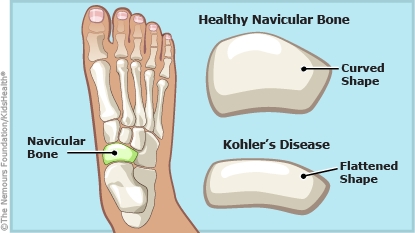Kohler's Disease: How to Care for Your Child
Kohler's disease is a rare cause of foot pain in children. A cast helps to rest the bone so it can heal.


Kohler's disease develops from temporary changes in bones in the feet as kids grow. It is most common in boys between 2 and 10 years old, but also can occur in girls. Usually, it affects just one foot. With proper treatment, the bone almost always heals completely.
Health care providers do not know the exact cause of Kohler's disease, but in some kids, activities like walking, running, and jumping cause a developing bone between the ankle and the heel (the navicular bone) to lose some of its blood supply and become flattened. These changes cause pain, swelling, and tenderness on the inside of the foot and sometimes a limp.
Your health care provider diagnosed Kohler's disease through a physical examination of the foot. Sometimes an X-ray is done to make sure nothing else is causing the pain. Your health care provider may have felt that a cast from the knee down would relieve pain and help your child's foot heal faster.

-
If your child is uncomfortable, a medication may help:
-
Your health care provider may recommend ibuprofen or other nonsteroidal anti-inflammatory drug (NSAID) to help with swelling.
-
To care for your child's cast:
-
Do not get the cast wet. Use a plastic covering over the cast as directed during bathing and keep it completely out of the water by propping it up on something like a plastic milk crate. Older kids should avoid showers. Give sponge baths to kids under 5 years old.
-
For itching, tap lightly on the cast or use a hair dryer on the cool setting to blow air in and around the edges.
-
Don't allow your child to use any object to scratch under the cast. It can lead to infection or sores.
-
Don't apply lotion or powder inside the cast.
-
Encourage your child to wiggle the toes to keep blood circulating normally.
-
If a sharp edge on the cast irritates your child's skin, apply tape or moleskin to the edge.
-
Schedule follow-up appointments as recommended.

Your child:
-
Has pain that doesn't improve with pain medications and rest.
-
Has pain that is not improving or becomes worse at night.
-
Has a foul odor or drainage coming from the cast.
-
Has redness or irritation of the skin around the edge of the cast.

-
Your child is in severe pain.
-
Your child's toes turn white or blue.
-
The cast feels too tight or your child's foot feels numb and tingly.
-
The cast is cracked, loose, or wet.